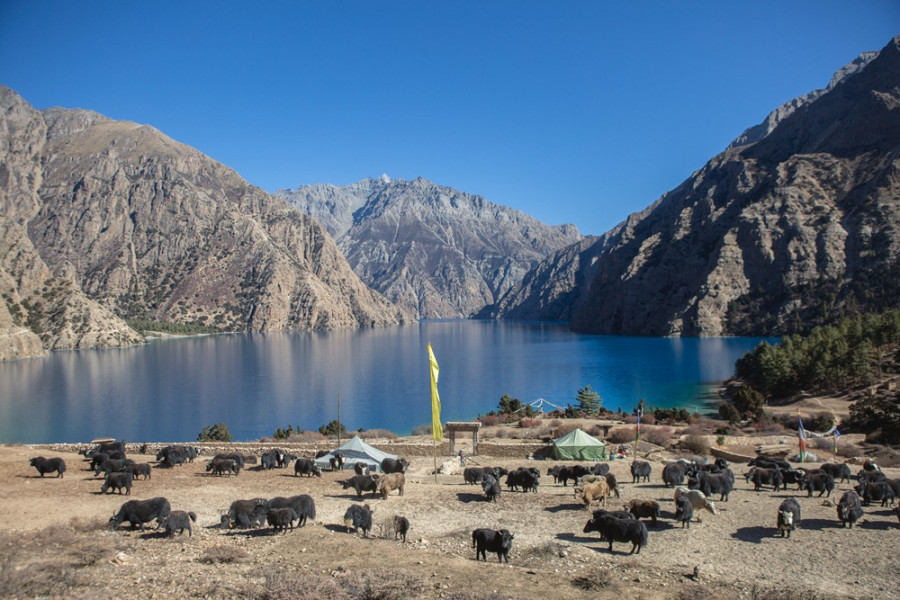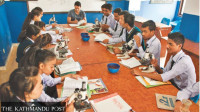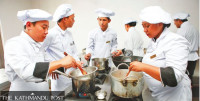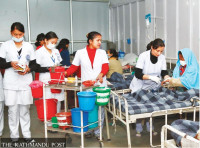Miscellaneous
Showcasing Dolpo
Imagine walking up lands wild and seemingly uncharted, stretching far into the oblivion. Imagine a dusk that rolls in glowing shades of pink and blue. Imagine rugged mountains, nothing giant but still sizeable, under stars a million strong.
Anuj D Adhikary
Text and photos: Anuj D. Adhikary
Imagine walking up lands wild and seemingly uncharted, stretching far into the oblivion. Imagine a dusk that rolls in glowing shades of pink and blue. Imagine rugged mountains, nothing giant but still sizeable, under stars a million strong.
After close to eleven hours of walking with not a soul crossing path, we decided to camp here—in plain view of Dolpo’s barren lands, snowcapped peaks and shining stars. Mountain-kissed gusts showed no remorse to our exhausted bodies and minds, or for that matter, our tent that almost took off into thin air on several occasions. As much as we yearned for the majestic sight to last forever, we didn’t. At almost 5,000m altitude, right at the base of Langmuse pass—inevitable climb for next day—the chill was seeping into our bones.
Unfortunately or not, dinner was to be made and had. We scrambled to fetch water by a stream near our tent. Shivering convulsively we would barely make it back to the campsite only to realise the water in the pans had frozen solid—in less than a couple of minutes. It was either hypothermic ice for dinner or three-day-stale khichadi which yet had to be thawed by burning dry yak droppings we collected in pitch darkness. An unhearty meal later, smelling like smoked cow poop, I ransacked my backpack to retrieve all the clothes I could find, for the chill was far from gone. Three layers of socks, among others, later I dozed off the frigid night.
At the crack of dawn next day, we walked over Langmuse and another pass, crossing surreal landscapes to finally reach Dho Tarap village, the first civilisation we saw in two days. On topsy-turvy trails with gorgeous views and scary drops to the river below, we continued on to Dunai, and then back to Juphal, concluding a circuit on Upper Dolpo.
The turquoise glacial lake of Phoksundo, surrounded by mysterious and arid cliffs, without a shadow of doubt is Dolpo’s gem. Beyond the idylls of a lake, however, lies Dolpo in its true brilliance, exuding nothing but the wild, a sense of solitude and an exotic civilisation—an experience which cannot be taught by textbooks, and must be witnessed to be believed, and touched to fathom.
It would be inconclusive to define the vastness of Dolpo merely by Phoksundo Lake. These photos that explore Dolpo beyond the beaten path were taken on assignment with the Great Himalaya Trails.
Dolpo lies in mid-western part of Nepal and makes a part of Shey Phoksundo National Park. Located between Mugu and Mustang, it borders Tibet to the north, where a large part of the local culture is derived from. Dolpo can be reached by a short flight from Nepalgunj to Juphal village, situated about three hours walking from Dunai.

Dwarfed by Kangtekatong mountain, Ringmo gets up early with chilly gusts of winds fluttering Buddhist prayer flags by the lake. Kangtekatong in Tibetan stands for horse saddle, owing to its shape. (Ringmo village)

The turquoise colours of Phoksundo are clearly visible on the climb up from the lake. Three treacherous hours of hike up on rocky cliffs take you to the other side of the lake. A mélange of barren cliffs and forests, coupled with the deep blue colours of the lake, make this hike definitely worth it. (Forest Camp)

Walking along the trails to Dho Tarap. The unnamed peak seen at the horizon is tiny compared to the giants of the Himalayas, and in fact, is almost at the same level as Langmuse Pass, en route the valley of Dho. (en route base of Langmuse Pass)

A tent is pitched next to Shey Gompa. At 4,600m, the tiny village is well above the treeline, and is dominated by a vast expanse of rolling snowy landscape. (Shey Gompa)

A woman winnows grains on her roof top with a little help of heavy winds typical in Phoksundo. (Ringmo village)

Morning sun touches down on Dho and arid hills that surround it. (Dho Tarap)

As winter looms, yaks are brought to lower altitudes on narrow and dusty trails carved against Phoksundo’s cliffs. The perilous journey is not without its share of fatal mishaps as cattle tumble into the deep waters. Here, hundreds of yaks bask in the sun by Phoksundo on their way from Nagdalo Pass (5,350m) headed farther down. (Ringmo village)

As night falls, the mystical skies put up a colourful show of burning orange and blue hues over the desert terrain of Dolpo. (Base of Langmuse Pass)

People migrating from higher altitudes of Dolpo to lower, warmer regions spend a night in the caves of Chhugor on their long journey. The cave bonfire perfectly complements Dolpo’s starry night sky. (Chhugor)

Head priest of the 700-year old Shey Gompa, the oldest and most revered monastery in Dolpo, located on foothills of the sacred Crystal Mountain. (Shey Gompa)

Cold and frosty, a sleepy yak refuses to budge as its handler attempts to move it to grass fields for grazing. Dry yak dropping is commonly used for cooking as other alternatives are hard to reach, hence expensive, in secluded settlements of Dolpo, especially above the treeline. (Ringmo village)

A local woman in Dho adorned in traditional ornaments. (Dho Tarap)




 16.12°C Kathmandu
16.12°C Kathmandu








%20(1).jpg&w=300&height=200)

